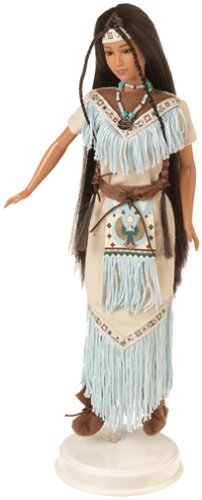 Another Stereotype of the Month entry:
Another Stereotype of the Month entry:
 Another Stereotype of the Month entry:
Another Stereotype of the Month entry:
February 12, 2002
The Globe and Mail
Native Barbie reinforces stereotypes, lecturer says
By ROMA LUCIW
On the eve of her 43rd birthday, Barbie is no stranger to controversy.
She is under fire again, this time not for her buxom figure or stunted brainpower but for the traditional costumes that accompany Mattel's popular Native American Barbie line.
The problem, says Patricia McCormack, a professor at the University of Alberta's school of native studies, is that the dolls reinforce stereotypes about aboriginal people. Certainly, they do not follow other Barbies' liberated paths.
"They do not have a native American vet, lawyer or schoolteacher. They are always dressed up as these beautiful Pocahontas-type princesses," she said.
Mattel's Spirit of the Earth Barbie is the first in the Native Spirit collection.
This native babe with long brown braids sports a tan suede dress with fringe, a fur-trimmed coat, some colourful beads and a matching decorated headband.
"It's a stereotyped toy," Ms. McCormack said, and is as dangerous as bows and arrows, tepees, and totem poles in reinforcing false ideas of "nativeness."
The doll's makers reject the criticism, saying the traditional garb and feathers are meant to highlight the beauty of native culture.
"From a collecting perspective, there is a huge interest in these dolls. People of all ages have a fascination with traditional native American artifacts and clothing," said Jill Nordquist, a senior product manager for Barbie Collectibles.
The first collectible native Barbie appeared in 1993. Of the one billion Barbies sold since the company started in 1959, more than one million have been aboriginal dolls.
The Barbie Collectibles Web site features descriptions of the native dolls. The one accompanying the Southern Plains doll says the Barbie is "dressed in an updated version of a tribal princess costume" to complete her "modern powwow look."
Such flowery rhetoric does not help, Ms. McCormack said. And without the traditional gear, she added, native Barbie, who has long dark hair and slightly darker skin, would not be easily recognized as aboriginal.
Ms. McCormack does not object to Spirit of the Earth Barbie being sold with her traditional outfit, but she wants this to be "only one of her many roles as a modern North American woman."
Speaking at the University of Alberta on Sunday, Ms. McCormack challenged her audience to examine their own stereotypes about natives by re-dressing Barbie as a true Albertan: a rancher.
To mix up the roles of the cowboy and Indian story line, she dressed a Blackfoot Barbie in blue jeans, a red flannel shirt and a vest. The result was a Blackfoot barrel-racer Barbie.
Ms. McCormack acknowledged that Barbie is an easy target, and said the doll would not be such a problem if there were greater understanding among the general population about native issues and aboriginals as modern people.
"There are no bridges we seem to be able to build," she said, noting that toys such as Native Barbie just make things worse.
Rob's comment
The only time I ever saw someone wearing buckskins at a powwow was when one dance group did a traditional Deer Dance. I've seen women in traditional dresses, but they tend to involve full-length skirts, long-sleeved blouses, and jewelry, not buckskin. The Western ranch outfit described above would be much more typical.
More important, there's no such thing as a Plains "tribal princess" or "tribal princess costume," so there's nothing to update. The doll is plainly stereotypical.
Related links
Indian women as sex objects
|
. . . |

|
All material © copyright its original owners, except where noted.
Original text and pictures © copyright 2007 by Robert Schmidt.
Copyrighted material is posted under the Fair Use provision of the Copyright Act,
which allows copying for nonprofit educational uses including criticism and commentary.
Comments sent to the publisher become the property of Blue Corn Comics
and may be used in other postings without permission.